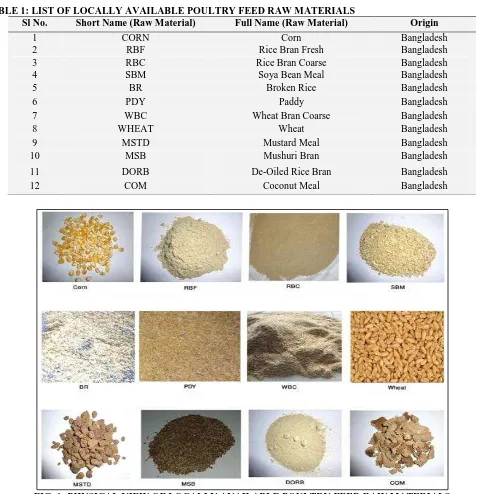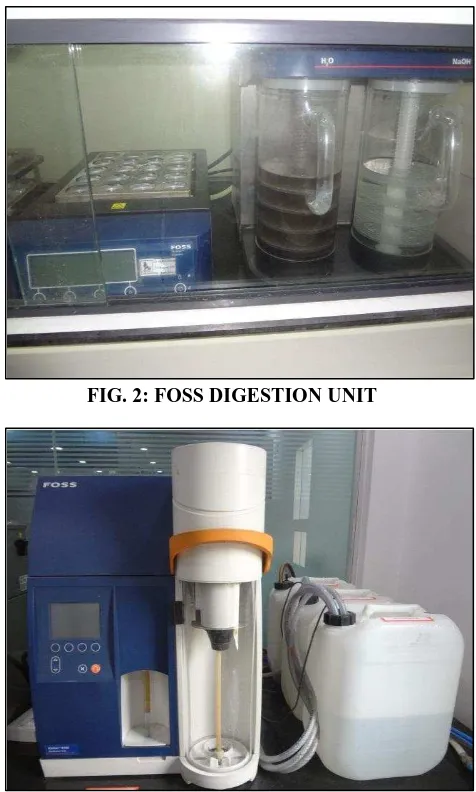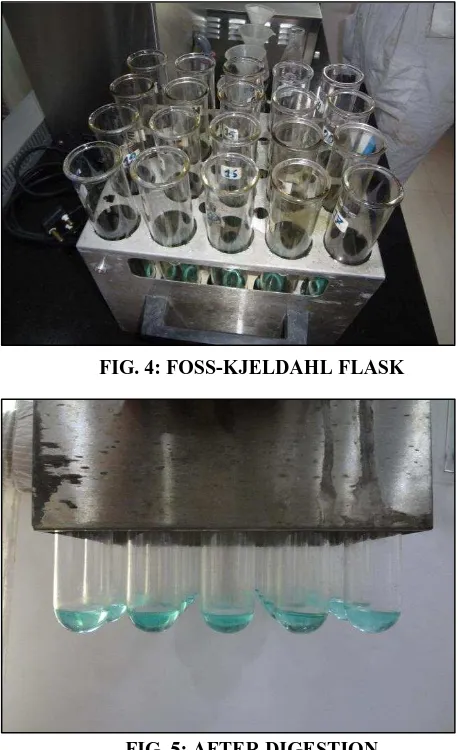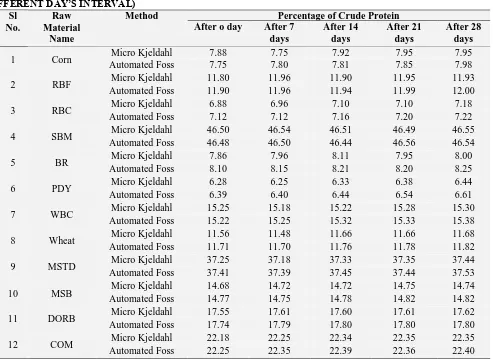IJPSR (2015), Vol. 6, Issue 5 (Research Article)
Received on 03 September, 2014; received in revised form, 29 November, 2014; accepted, 27 January, 2015; published 01 May, 2015
ESTIMATION OF MOISTURE AND CRUDE PROTEIN CONTENT OF LOCALLY AVAILABLE RAW MATERIALS FOR POULTRY FEED
Md. Saiful Islam *1, Md. Moinul Haque 1 and Md. Shakhawat Hossain 2
Department of Applied Chemistry & Chemical Engineering 1, Rajshahi University, Rajshahi-6205, Bangladesh
Bangladesh Sericulture Research and Training Institute 2, Rajshahi-6207, Bangladesh
ABSTRACT: There are some locally available domestic material in
our country that can be used in poultry feed. The uses of local material will decrease the feed cost as well as ensure the availability of raw materials. In this investigation we have selected twelve locally available domestic materials that are low cost and nutritious for poultry health. These raw materials play an important role on poultry health. For crude protein estimation we have used manual micro Kjeldahl method. We have applied also micro Kjeldahl automated Foss instrument to measure and compare results of crude protein content of our selected raw materials. Moisture content of these raw materials is also estimated by three different methods, because moisture plays an important role during storing and formulation of poultry feed. In this study it was found that all of the local raw materials contain considerable amount of crude protein. Though all the selected raw materials contain considerable amount of crude protein, among them soya bean meal (SBM) contains higher amount of crude protein (46.53%)
INTRODUCTION: Bangladesh is an agricultural and developing country. Now a day’s agribusiness
is growing up very fast in Bangladesh. Most of the establishment uses foreign raw materials 1 for producing poultry feed. If we can introduce locally available domestic material such as corn 2, rice bran, paddy, soya bean meal, mustard meal, wheat bran etc. those contains appreciable amount of nutritious values, and then many companies will start to use domestic material.
QUICK RESPONSE CODE
DOI:
10.13040/IJPSR.0975-8232.6(5).1900-06
Article can be accessed online on:
www.ijpsr.com
DOI link: http://dx.doi.org/10.13040/IJPSR.0975-8232.6(5).1900-06
As a result the demand of domestic material will be increased day by day as well as the feed price will be reasonable for poultry farmers. On the other hand the raw materials are no need to import from foreign country. So company can save cost in this regard. These raw materials may contain different nutrients, such as, carbohydrate, moisture, protein
3
, fat, fiber and calcium etc. which has a great influence on poultry health. Among these nutrients, protein is considered as a main constituent to build up the poultry health. The present study was undertaken to introduce only protein content of some domestic material that can be used as poultry feed raw materials. Specially for measuring crude protein (CP)4, Micro Kjeldahl process 5, 6 is used. Micro Kjeldahl process is reliable for measuring crude protein.
Keywords:
Crude protein; Poultry feed raw material; Moisture; Kjeldahl method;
Foss instrument Correspondence to Author: Md. Saiful Islam
Lecturer
TABLE 1: LIST OF LOCALLY AVAILABLE POULTRY FEED RAW MATERIALS
Sl No. Short Name (Raw Material) Full Name (Raw Material) Origin
1 CORN Corn Bangladesh
2 RBF Rice Bran Fresh Bangladesh
3 RBC Rice Bran Coarse Bangladesh
4 SBM Soya Bean Meal Bangladesh
5 BR Broken Rice Bangladesh
6 PDY Paddy Bangladesh
7 WBC Wheat Bran Coarse Bangladesh
8 WHEAT Wheat Bangladesh
9 MSTD Mustard Meal Bangladesh
10 MSB Mushuri Bran Bangladesh
11 DORB De-Oiled Rice Bran Bangladesh
12 COM Coconut Meal Bangladesh
FIG. 1: PHYSICAL VIEW OF LOCALLY AVAILABLE POULTRY FEED RAW MATERIALS
MATERIALS AND METHOD: Estimation of moisture:
Moisture is an important factor for a raw material to store or use in feed. Depending on the moisture range of a raw material we can store for different period. Not only store, it plays an important role during formation of feed. So, investigation was started by checking the moisture content of these raw materials.
PROCEDURE:
1. At first the petridis was cleaned by distilled water and was kept it into dryer for 10 min.,
after that the petridis was transferred to a desiccators for cooling.
2. Weight was taken of the dry petridis as M1. 3. The grinding sample was taken about 2-5
gm. in that dry petridis as M2.
4. The Petridis was then placed in an oven (oven temp. was previously set-up 105 Degree Celsius.) for 16 hrs.
5. After that the Petridis was transferred to desiccators for cooling.
Calculation:
M1= Weight of empty Petridis
M2= Weight of empty Petridis + sample
M3= Weight of empty Petridis + sample after dry
Estimation of crude protein:
In this investigation there are two process of Kjeldahl method were used to estimate and compare the crude protein content. i.e.:
i) Micro Kjeldahl method (Manual)
ii) Micro Kjeldahl method (Automated Foss Instrument)
Equipment’s:
i) Grinder Machine (Particle size ≤ 1mm)
ii) Electronic Balance 4 Digit
iii) Spoon
iv) Tracing Paper
v)Graduated Measuring Cylinder, of capacity 25ml.
vi) Laboratory Fume Hood
vii) Digestion System Foss Tecator TM 8 digester
viii) Scrubber TM 2501 Tecator
ix) Digestion tube, of capacity 250 ml, suitable for use in digestion block.
x) Conical Flask
xi) Distillation System KjeltecTM 8100
xii) Eyela-CA-1112E Water Cooler Systems
xiii) Puris-Expe RO Water System
xiv) Burette, of capacity 50ml
xv) Pipette (5ml, 10ml, and 25 ml.)
xvi) Reagent Bottle (250ml, 500ml)
xvii) Volumetric Flask (100ml, 250ml, 500ml,
ii) For distillation : Mixed indicator (Methyl red + Methylene blue), NaOH 50% solution&H3BO3
4% solution
iii) For Titration : 0.2 N H2SO4 solution.
Preparation of solution:
i) Phenolphthalein Indicator : 0.5gm. Phenolphthalein + 50 ml 95% Ethanol
ii) Mixed indicator : 0.2 gm. Methyl Red
distilled water = Total volume 1000 ml.
v) 0.2 N H2SO4 : 11 ml conc. 98%
H2SO4 + 1989 ml
distilled water = Total volume 2000 ml.
Standardization of 0.2 N H2SO4solution:
Approximate 0.1 gm. pure and dry Na2CO3was
taken in a 250 ml conical flask and 50 ml distilled water was added and then it was titrated with H2SO4 solution in presence of 1 drop methyl red
indicator. Then the normality of H2SO4 solution
was calculated by the following equation.
Digestion procedure:
i) Approximately 0.5 to 1 gm. of ground homogenous sample was taken in a piece of tracing paper. The paper is carefully folded so that, the sample is well contained. The folded sample was then placed into digestion tube.
ii) When the digestion unit has been on for an adequate warm-up period, then 15-20 ml of concentrated H2SO4 to each tube and also 4
iii) After completing sample and reagent addition to the digestion tubes, it was carefully inserted into the holes provided in the flask rack or heating mantle.
iv) The exhaust fan of the digestion chamber was turned on.
v) The sample was then digested at 3500C for approximately 120-150 minute or until the sample have a clear, blue-green appearance.
vi) After digestion was completed, the flask was removed from the rack or heating mantle. The hot tubes are carefully handled so that, it cannot come into contact with cool or wet surface. As a safety precaution gloves and goggles were used when removing the tubes from digester.
vii) The tubes were allowed to cool for 15 to 20 minutes. When the tubes have cooled enough then it was diluted with 50 ml of distilled water so that, the digested sample is fully dissolved.
Distillation procedure:
i) The digestion sample was transferred to the distillation unit
ii) 60 ml 50% NaOH solution was added to the unit very slowly.
iii) A receiving Erlenmeyer flask containing 25 ml boric acid solution was placed to collect the distillate.
iv) The distillate was collected up to 150 ml. v) The distillate was then titrated with std. 0.2
N H2SO4 solution. (End point was
violet-grey.)
Crude protein (% CP) calculation:
Crude protein is an estimate for total protein. A crude protein contains nitrogen from not only protein but non-protein sources as well. Crude protein is used for energy and helps build tissue. Crude Protein (CP) is based on a laboratory nitrogen analysis, from which the total protein content in a material can be calculated by multiplying the nitrogen figure by 100/16 or 6.25. This is from the assumption that nitrogen is derived from protein containing 16 % nitrogen (AOAC, 1984). However, some portion of the N in most raw materials are found as non-protein nitrogen (NPN)
and, therefore, the value calculated by multiplying N x 6.25 is referred to as crude rather than true protein. Protein is made up of amino acids.
So normally %CP is calculated by the following equation:
A mixture of true protein and non-protein nitrogen in a material is called crude protein. The approximate amount of protein is calculated from the determined nitrogen content by multiplying by a factor (as 6.25 for many foods and 5.7 for wheat) derived from the average percentage of nitrogen that may contain an appreciable error if the nitrogen is derived from non-protein material or from a protein of unusual composition.
FIG. 2: FOSS DIGESTION UNIT
FIG. 4: FOSS-KJELDAHL FLASK
FIG. 5: AFTER DIGESTION
Manual digestion is comparatively time consuming then automatic foss digestion, but foss digestion is
costly then manual. Heating system and
arrangement for automatic foss digestion is totally different from manual. Under all consideration, automatic foss digestion is reliable, easy to handle and also environment friendly.
RESULTS AND DISCUSSION: The moisture
content of different kinds of raw material has been compared between the oven method, IR method and normal moisture taster. Moisture taster is a simple and small machine by which grain moisture can measure within a very short time. But it is not reliable, only we can guise about the moisture level of the raw material. The results are given below. Same sample is used to measure %CP at different daysof interval. This investigation was done after
seven day’s interval within a month, because all of
the raw materials are to stock for one or two month for using in feed. After storing for a long day’s there is a possibility to deviate the nutrientslevel, so
this research will ensure the nutritionist about the stability of %CP of these raw materials.
Raw Material Name
FIG. 6: PERCENTAGE MOISTURE LEVEL OF RAW
MATERIALS BY DIFFERENT METHODS
FIG. 7: PERCENTAGE CRUDE PROTEIN LEVEL OF RAW MATERIALS
TABLE 2: PERCENTAGE OF MOISTURE CONTENT OF LOCALLY AVAILABLE RAW MATERIALS (AT DIFFERENT METHOD)
Sl No.
Raw Material
Name
Percent Moisture Method
Oven IR Moisture
Taster 1 CORN 11.24 11.92 13.50
2 RBF 9.70 8.75 10.40
3 RBC 8.10 8.52 8.70
4 SBM 10.77 10.85 11.80
5 BR 11.62 11.45 12.80
6 PDY 10.35 10.72 11.80
7 WBC 9.82 10.11 10.60
8 WHEAT 11.22 11.15 12.30
9 MSTD 9.12 9.56 10.50
10 MSB 8.42 10.55 9.20
11 DORB 11.32 10.80 11.80
The crude protein content of different kinds of raw
Method Percentage of Crude Protein
After o day After 7
materials contain considerable amount of %CP, among them SBM, MSTD and COM contain higher amount of %CP (46.53%, 37.31% and 22.29% respectively). Due to inadequate facilities and shortage of manpower we have considered only %CP in this study, but there are some positive future opportunities to estimate the rest of the nutrients of these raw materials. If all nutrients can estimate belongs to these raw materials then it will be more helpful for the nutritionist to formulate poultry feed.These raw materials easily can use in poultry feed, because these are locally available as well as low cost. If we can make a trend to use
University and research laboratory of poultry feed factory, Rajshahi, Bangladesh for assisting to achieve the goal of this study.
REFERENCES:
1.Bao YM, Filer K, Sanomwattanawong J, Jantasila N, Pandey H & Congsagul S In-vitro assessment of anti-oxidative activities in rice bran, palm kernel meal, soybean meal and corn feed ingredients. Proceedings of the Australian Poultry Science Symposium 22; 2011: 222-225
2.Shukla, R. & Cheryan, M. Zein, The industrial protein from corn. Ind. Crops Prod.13, 2001: 171– 192.
3.Dr. D. Julian McClements, Analysis of Proteins. University of Massachusetts Amherst. 04-27, Retrieved 2007.
5.Sun, T., Z. Liu, L. Qin, and R. Long. Aspects of lipid oxidation of meat from free-range broilers consuming a diet containing grasshoppers on alpine steppe of the Tibetan Plateau. Poultry Science. 91; 2012 : 224-231.
6.Liu SY, Selle PH, Cowieson AJ, The kinetics of starch and nitrogen digestion regulate growth performance and nutrient utilisation in coarsely-ground, sorghum-based broiler diets 2013.
All © 2013 are reserved by International Journal of Pharmaceutical Sciences and Research. This Journal licensed under a Creative Commons Attribution-NonCommercial-ShareAlike 3.0 Unported License.
This article can be downloaded to ANDROID OS based mobile. Scan QR Code using Code/Bar Scanner from your mobile. (Scanners are available on Google Playstore)
How to cite this article:



